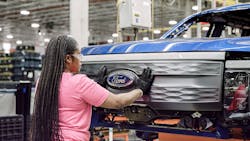EV cost parity still a decade away: Ford CEO
Electric vehicles still have years to go before they become cost-competitive with vehicles running on internal combustion engines, according to Ford Motor CEO Jim Farley.
Speaking during an investor conference last week, the OEM leader said that the company would need at least another product generation to simplify the designs of its electric vehicles and reduce costs. He said the cost parity target for a typical $40,000 EV will be between 2030 and 2035, during Ford's transition from its second to its third cycle of EV products. By then, he added, lithium iron phosphate batteries will dominate, and Ford will have "dramatically lower labor content and dramatically lower distribution costs."
See also: Daimler, Toyota strike deal to merge Fuso and Hino
Ford had the largest market share of new medium-duty truck sales last year, according to American Truck Dealers data. Its lighter-duty F-series trucks and commercial vans are among the most popular vehicles for light-duty fleets. The company began selling battery-electric versions—F-150 Lightning and E-Transit—in model year 2022.
Ford's CEO added that price competition concentrates on specific EV categories—but Ford's F-150 Lightning truck and E-Transit van are not being affected. He also stated that the pain among mass-market EV manufacturers would be "much, much harsher than people think" in order to significantly increase adoption rates.
Farley has long been hammering away at the need for simpler vehicle designs—and told the audience at the May 31 conference hosted by research firm Bernstein that the second generation of Ford EVs will have 40% fewer fasteners, for instance—but also said that “a lot more regulatory support” than the new $7,500 tax credit will be needed to get EV adoption rates to 50% of the U.S. market over time.
For more coverage of Farley’s remarks and details on how another global vehicle maker is creating its own “sustainable business model,” read this article by our colleague Senior Editor Geert De Lombaerde at IndustryWeek.com.
About the Author
FleetOwner Staff
Our Editorial Team
Kevin Jones, Editorial Director, Commercial Vehicle Group
Josh Fisher, Editor-in-Chief
Jade Brasher, Senior Editor
Jeremy Wolfe, Editor
Jenna Hume, Digital Editor
Eric Van Egeren, Art Director

